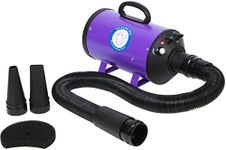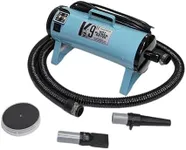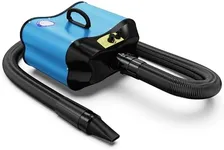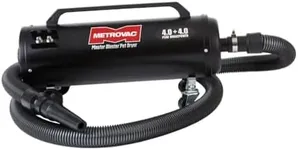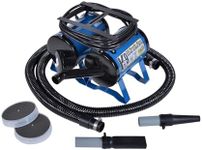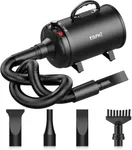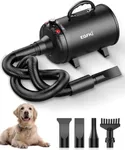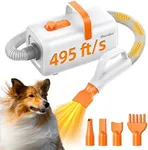Buying Guide for the Best Dog Blowers
Choosing the right dog blower can make a significant difference in grooming your pet efficiently and comfortably. Dog blowers are essential tools for drying your dog's coat quickly after a bath, reducing the risk of skin infections, and keeping their fur looking its best. When selecting a dog blower, it's important to consider several key specifications to ensure you pick the best fit for your dog's needs and your grooming routine.Power (Wattage)Power, measured in watts, indicates the strength of the blower. Higher wattage means more powerful airflow, which can dry your dog faster. For small dogs with short coats, a lower wattage blower (around 500-1000 watts) may be sufficient. Medium to large dogs or those with thick, long coats may require a higher wattage blower (1000-2000 watts or more) to ensure efficient drying. Consider your dog's size and coat type when choosing the power level.
Airflow SpeedAirflow speed, often measured in feet per minute (FPM) or cubic feet per minute (CFM), determines how quickly the air is expelled from the blower. Adjustable speed settings are beneficial as they allow you to control the intensity of the airflow. Lower speeds are gentler and suitable for sensitive areas or nervous dogs, while higher speeds are effective for quickly drying thick or long coats. Choose a blower with variable speed settings to accommodate different drying needs.
Heat SettingsHeat settings allow you to control the temperature of the air being blown. Some dogs may be sensitive to high heat, so having adjustable heat settings can help prevent discomfort or skin irritation. Blowers with multiple heat settings, including a no-heat option, provide flexibility and safety. If your dog has a thick or long coat, a warm setting can speed up the drying process, but always monitor the temperature to avoid overheating.
Noise LevelNoise level is an important consideration, especially for dogs that are easily frightened by loud sounds. Quieter blowers are more comfortable for both the dog and the groomer. Noise levels are usually measured in decibels (dB). Look for blowers that are specifically designed to operate quietly, typically under 70 dB. If your dog is particularly noise-sensitive, prioritize a low-noise model to make the grooming experience less stressful.
Hose Length and FlexibilityThe length and flexibility of the hose can impact the ease of use and maneuverability of the blower. A longer hose allows you to move around your dog more freely without having to reposition the blower unit. Flexible hoses are easier to handle and can reach difficult areas. Consider the size of your grooming space and how much mobility you need when choosing the hose length and flexibility.
Attachments and AccessoriesAttachments and accessories, such as different nozzle types, can enhance the functionality of the blower. Nozzles can concentrate or diffuse the airflow, making it easier to dry specific areas or types of coats. Some blowers come with comb attachments that help detangle fur while drying. Think about your dog's coat type and grooming needs to determine which attachments will be most useful for you.
Portability and StoragePortability and storage features are important if you need to move the blower around or have limited storage space. Lightweight and compact blowers are easier to carry and store. Some models come with handles or wheels for added convenience. If you travel frequently or have a small grooming area, consider a blower that is easy to transport and store.


